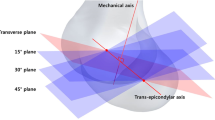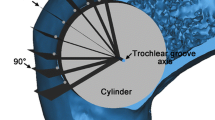Abstract
Purpose
This study aimed to analyze the morphology of the anterior femoral condyle using a quantitative three-dimensional reconstruction method. The morphological data were compared between genders.
Methods
Computed tomography scans of femurs were taken from 90 healthy subjects and then reconstructed in 3D modeling software. Coaxial cutting planes were created at 10° increments to measure the lateral and medial anterior condylar heights (LACH and MACH, respectively), lateral and medial trochlear groove widths (LTW and MTW, respectively), and for trochlear groove tracking. The absolute values and normalized data were compared between male and female subjects. The sulcus angle and deepest point of the trochlear groove at each cross-section were also analyzed to determine the differences in the depth of the trochlear groove.
Results
The absolute dimensions of LACH, MACH, LTW, and MTW were significantly smaller in the female subjects, by 10.5%, 36.9%, 10.3%, and 11.0%, respectively, than in the males (p < 0.05). After normalization, no significant difference was found in the condylar height between the genders. However, the female subjects had a significantly larger value of approximately 7.9% for the normalized trochlear width.
Conclusion
Male subjects had greater condylar heights and widths than the female subjects. Although the trajectory of the trochlear groove varied greatly among the subjects, the trochlear groove appeared to be wider and shallower in the female subjects than in the male subjects. These results provide important information for the design of femoral trochlea to fit Asian female patients.
Level of evidence
III.






Similar content being viewed by others
References
Barink M, van de Groes S, Verdonschot N, de Waal MM (2003) The trochlea is bilinear and oriented medially. Clin Orthop Relat Res 411:288–295
Chang TW, Huang CH, McClean CJ, Lai YS, Lu YC, Cheng CK (2012) Morphometrical measurement of resected surface of medial and lateral proximal tibia for Chinese population. Knee Surg Sports Traumatol Arthrosc 20:1730–1735
Chantarapanich N, Sitthiseripratip K, Mahaisavariya B, Wongcumchang M, Siribodhi P (2011) 3D geometrical assessment of femoral curvature: a reverse engineering technique. J Med Assoc Thai 91:1377
Chen S, Du Z, Yan M, Yue B, Wang Y (2017) Morphological classification of the femoral trochlear groove based on a quantitative measurement of computed tomographic models. Knee Surg Sports Traumatol Arthrosc 25:3163–3170
Dejour D, Ntagiopoulos PG, Saffarini M (2014) Evidence of trochlear dysplasia in femoral component designs. Knee Surg Sports Traumatol Arthrosc 22:2599–2607
Du Z, Chen S, Yan M, Yue B, Zeng Y, Wang Y (2017) Do size, shape, and alignment parameters of the femoral condyle affect the trochlear groove tracking? A morphometric study based on 3D-computed tomography models in Chinese people. BMC Musculoskelet Disord 18:4
Fan L, Xu T, Li X, Zan P, Li G (2017) Morphologic features of the distal femur and tibia plateau in Southeastern Chinese population: a cross-sectional study. Medicine 96:e8524
Fehring TK, Odum SM, Hughes J, Springer BD, Beaver WB Jr (2009) Differences between the sexes in the anatomy of the anterior condyle of the knee. J Bone Jt Surg Am 91:2335–2341
Fitzpatrick CK, Baldwin MA, Ali AA, Laz PJ, Rullkoetter PJ (2011) Comparison of patellar bone strain in the natural and implanted knee during simulated deep flexion. J Orthop Res 29:232–239
Greene KA (2007) Gender-specific design in total knee arthroplasty. J Arthroplasty 22:27–31
Guy S, Farndon M, Sidhom S, Al-Lami M, Bennett C, London N (2012) Gender differences in distal femoral morphology and the role of gender specific implants in total knee replacement: a prospective clinical study. Knee 19:28–31
Heinert G, Kendoff D, Preiss S, Gehrke T, Sussmann P (2011) Patellofemoral kinematics in mobile-bearing and fixed-bearing posterior stabilised total knee replacements: a cadaveric study. Knee Surg Sports Traumatol Arthrosc 19:967–972
Hochreiter B, Hess S, Moser L, Hirschmann MT, Amsler F, Behrend H (2020) Healthy knees have a highly variable patellofemoral alignment: a systematic review. Knee Surg Sports Traumatol Arthrosc 28:398–406
Huang CH, Hsu LI, Chang TK, Chuang TY, Shih SL, Lu YC et al (2017) Stress distribution of the patellofemoral joint in the anatomic V-shape and curved dome-shape femoral component: a comparison of resurfaced and unresurfaced patellae. Knee Surg Sports Traumatol Arthrosc 25:263–271
Iranpour F, Merican AM, Dandachli W, Amis AA, Cobb JP (2010) The geometry of the trochlear groove. Clin Orthop Relat Res 468:782–788
Ishimaru M, Hino K, Onishi Y, Iseki Y, Mashima N, Miura H (2014) A three-dimensional computed tomography study of distal femoral morphology in Japanese patients: gender differences and component fit. Knee 21:1221–1224
Kim JM, Kim SB, Kim JM, Lee DH, Lee BS, Bin SI (2015) Results of gender-specific total knee arthroplasty: comparative study with traditional implant in female patients. Knee Surg Relat Res 27:17–23
Kim TK, Chung BJ, Kang YG, Chang CB, Seong SC (2009) Clinical implications of anthropometric patellar dimensions for TKA in Asians. Clin Orthop Relat Res 467:1007–1014
Koh YG, Nam JH, Chung HS, Kim HJ, Chun HJ, Kang KT (2019) Gender differences in morphology exist in posterior condylar offsets of the knee in Korean population. Knee Surg Sports Traumatol Arthrosc 27:1628–1634
Koh YG, Nam JH, Chung HS, Lee HY, Kim HJ, Kim HJ et al (2019) Gender-related morphological differences in sulcus angle and condylar height for the femoral trochlea using magnetic resonance imaging. Knee Surg Sports Traumatol Arthrosc 27:3560–3566
Li P, Tsai TY, Li JS, Wang S, Zhang Y, Kwon YM et al (2014) Gender analysis of the anterior femoral condyle geometry of the knee. Knee 21:529–533
Li P, Tsai TY, Li JS, Zhang Y, Kwon YM, Rubash HE et al (2014) Morphological measurement of the knee: race and sex effects. Acta Orthop Belg 80:260–268
Ma HM, Lu YC, Kwok TG, Ho FY, Huang CY, Huang CH (2007) The effect of the design of the femoral component on the conformity of the patellofemoral joint in total knee replacement. J Bone Jt Surg Br 89:408–412
Mahaisavariya B, Saekee B, Sitthiseripratip K, Oris P, Tongdee T, Bohez E et al (2004) Morphology of the radial head: a reverse engineering based evaluation using three-dimensional anatomical data of radial bone. Proc Inst Mech Eng H 218:79–84
Mahaisavariya B, Sitthiseripratip K, Tongdee T, Bohez EL, Vander Sloten J, Oris P (2002) Morphological study of the proximal femur: a new method of geometrical assessment using 3-dimensional reverse engineering. Med Eng Phys 24:617–622
Mahfouz M, Fatah EEA, Bowers LS, Scuderi G (2012) Three-dimensional morphology of the knee reveals ethnic differences. Clin Orthop Relat Res 470:172–185
Merchant AC, Arendt EA, Dye SF, Fredericson M, Grelsamer RP, Leadbetter WB et al (2008) The female knee: anatomic variations and the female-specific total knee design. Clin Orthop Relat Res 466:3059–3065
Pinskerova V, Nemec K, Landor I (2014) Gender differences in the morphology of the trochlea and the distal femur. Knee Surg Sports Traumatol Arthrosc 22:2342–2349
Schoettle PB, Zanetti M, Seifert B, Pfirrmann CW, Fucentese SF, Romero J (2006) The tibial tuberosity–trochlear groove distance; a comparative study between CT and MRI scanning. Knee 13:26–31
Smith RM, Boden BP, Sheehan FT (2018) Increased patellar volume/width and decreased femoral trochlear width are associated with adolescent patellofemoral pain. Clin Orthop Relat Res 476:2334–2343
Smith TO, Hunt NJ, Donell ST (2008) The reliability and validity of the Q-angle: a systematic review. Knee Surg Sports Traumatol Arthrosc 16:1068–1079
Tanavalee A, Rojpornpradit T, Khumrak S, Ngarmukos S (2011) The early results of gender-specific total knee arthroplasty in Thai patients. Knee 18:483–487
Wang J, Yue B, Wang Y, Yan M, Zeng Y (2012) The 3D analysis of the sagittal curvature of the femoral trochlea in the Chinese population. Knee Surg Sports Traumatol Arthrosc 20:957–963
Yan M, Wang J, Wang Y, Zhang J, Yue B, Zeng Y (2014) Gender-based differences in the dimensions of the femoral trochlea and condyles in the Chinese population: correlation to the risk of femoral component overhang. Knee 21:252–256
Yue B, Varadarajan KM, Ai S, Tang T, Rubash HE, Li G (2011) Differences of knee anthropometry between Chinese and white men and women. J Arthroplasty 26:124–130
Yue B, Varadarajan KM, Ai S, Tang T, Rubash HE, Li G (2011) Gender differences in the knees of Chinese population. Knee Surg Sports traumatol Arthrosc 19:80–88
Yue B, Wang J, Wang Y, Yan M, Zhang J, Zeng Y (2014) How the gender or morphological specific TKA prosthesis improves the component fit in the Chinese population? J Arthroplasty 29:71–74
Acknowledgements
The authors particularly thank Colin J. McClean for his kind assistance in language editing and proofreading this manuscript.
Funding
The authors are pleased to acknowledge the financial support of the Ministry of Science and Technology in Taiwan (MOST 105-2221-E-195-001) and a supporting grant from MMH and NTUST (MMH-NTUST-106-02).
Author information
Authors and Affiliations
Corresponding author
Ethics declarations
Conflict of interest
The authors report no conflicts of interest in this work.
Ethical approval
The study was approved by the Institutional Review Board of SCMH (IRB number: 1021004).
Informed consent
Informed consent was obtained from all enrolled subjects.
Additional information
Publisher's Note
Springer Nature remains neutral with regard to jurisdictional claims in published maps and institutional affiliations.
Rights and permissions
About this article
Cite this article
Hsu, CP., Lee, PY., Wei, HW. et al. Gender differences in femoral trochlea morphology. Knee Surg Sports Traumatol Arthrosc 29, 563–572 (2021). https://doi.org/10.1007/s00167-020-05944-3
Received:
Accepted:
Published:
Issue Date:
DOI: https://doi.org/10.1007/s00167-020-05944-3




